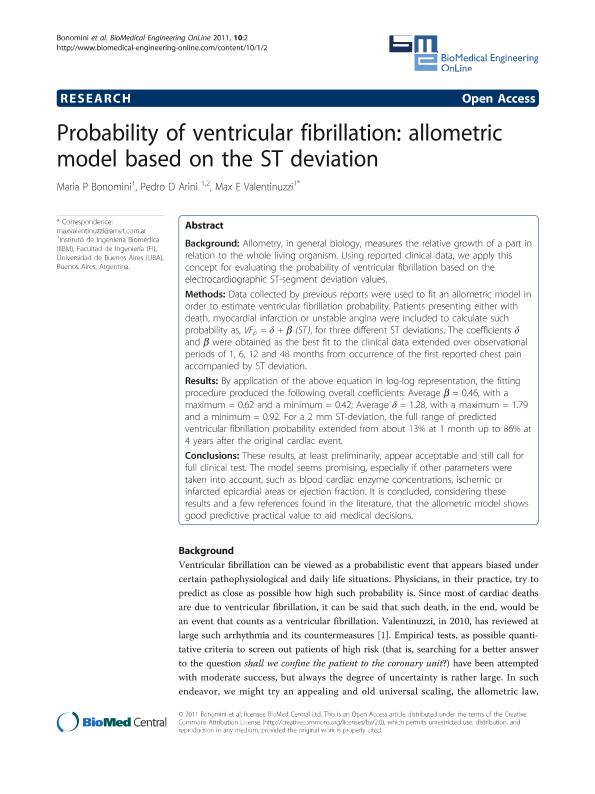Mostrar el registro sencillo del ítem
dc.contributor.author
Bonomini, Maria Paula

dc.contributor.author
Arini, Pedro David

dc.contributor.author
Valentinuzzi, Max E.
dc.date.available
2017-07-12T15:16:07Z
dc.date.issued
2011-01
dc.identifier.citation
Bonomini, Maria Paula; Arini, Pedro David; Valentinuzzi, Max E.; Probability of ventricular fibrillation: allometric model based on the ST deviation; BioMed Central; Biomedical Engineering Online; 10; 2; 1-2011; 1-8
dc.identifier.issn
1475-925X
dc.identifier.uri
http://hdl.handle.net/11336/20218
dc.description.abstract
Background
Allometry, in general biology, measures the relative growth of a part in relation to the whole living organism. Using reported clinical data, we apply this concept for evaluating the probability of ventricular fibrillation based on the electrocardiographic ST-segment deviation values.
Methods
Data collected by previous reports were used to fit an allometric model in order to estimate ventricular fibrillation probability. Patients presenting either with death, myocardial infarction or unstable angina were included to calculate such probability as, VF p = δ + β (ST), for three different ST deviations. The coefficients δ and β were obtained as the best fit to the clinical data extended over observational periods of 1, 6, 12 and 48 months from occurrence of the first reported chest pain accompanied by ST deviation.
Results
By application of the above equation in log-log representation, the fitting procedure produced the following overall coefficients: Average β = 0.46, with a maximum = 0.62 and a minimum = 0.42; Average δ = 1.28, with a maximum = 1.79 and a minimum = 0.92. For a 2 mm ST-deviation, the full range of predicted ventricular fibrillation probability extended from about 13% at 1 month up to 86% at 4 years after the original cardiac event.
Conclusions
These results, at least preliminarily, appear acceptable and still call for full clinical test. The model seems promising, especially if other parameters were taken into account, such as blood cardiac enzyme concentrations, ischemic or infarcted epicardial areas or ejection fraction. It is concluded, considering these results and a few references found in the literature, that the allometric model shows good predictive practical value to aid medical decisions.
dc.format
application/pdf
dc.language.iso
eng
dc.publisher
BioMed Central

dc.rights
info:eu-repo/semantics/openAccess
dc.rights.uri
https://creativecommons.org/licenses/by-nc-sa/2.5/ar/
dc.subject
Allometric Model
dc.subject
Cardiac Risk
dc.subject
St Segment Deviation
dc.subject.classification
Otras Ingenierías y Tecnologías

dc.subject.classification
Otras Ingenierías y Tecnologías

dc.subject.classification
INGENIERÍAS Y TECNOLOGÍAS

dc.title
Probability of ventricular fibrillation: allometric model based on the ST deviation
dc.type
info:eu-repo/semantics/article
dc.type
info:ar-repo/semantics/artículo
dc.type
info:eu-repo/semantics/publishedVersion
dc.date.updated
2017-07-12T13:19:17Z
dc.journal.volume
10
dc.journal.number
2
dc.journal.pagination
1-8
dc.journal.pais
Estados Unidos

dc.description.fil
Fil: Bonomini, Maria Paula. Universidad de Buenos Aires. Facultad de Ingeniería; Argentina. Consejo Nacional de Investigaciones Científicas y Técnicas. Oficina de Coordinación Administrativa Saavedra 15. Instituto Argentino de Matemática Alberto Calderon; Argentina
dc.description.fil
Fil: Arini, Pedro David. Universidad de Buenos Aires. Facultad de Ingeniería; Argentina. Consejo Nacional de Investigaciones Científicas y Técnicas. Oficina de Coordinación Administrativa Saavedra 15. Instituto Argentino de Matemática Alberto Calderon; Argentina
dc.description.fil
Fil: Valentinuzzi, Max E.. Universidad de Buenos Aires. Facultad de Ingeniería; Argentina
dc.journal.title
Biomedical Engineering Online

dc.relation.alternativeid
info:eu-repo/semantics/altIdentifier/url/http://www.biomedical-engineering-online.com/content/10/1/2
dc.relation.alternativeid
info:eu-repo/semantics/altIdentifier/doi/http://dx.doi.org/10.1186/1475-925X-10-2
Archivos asociados
